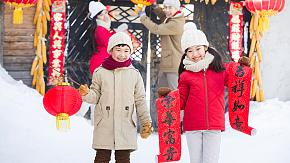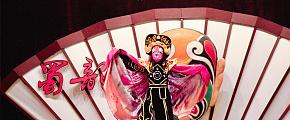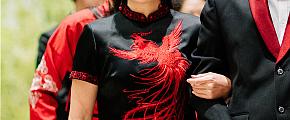Sceneries on CNY Banknotes
The Renminbi, or the Yuan, is the official currency of the People's Republic of China. It is issued by the People's Bank of China, the monetary authority of the PRC. The official abbreviation is CNY, although also commonly abbreviated as "RMB".
The newly-issued fifth series of RMB banknotes (1999 Edition and 2005 Edition) attract people's eyes with the top sceneries around China on the reverses. It will be very interesting to visit these places and find the exact locations of where the RMB pictures were taken. You will find the trip great fun and achieve "a sense of success". Start your exploration and enjoy your trip!
1 Yuan - West Lake, Hangzhou
The primary image on the reverse side of the new 1 Yuan note is the Three Pools Mirroring the Moon at West Lake in Hangzhou, Zhejiang Province.
The three pools actually refer to the three gourd-shaped stupas in the lake that seem to float on the water, each about 2 meters high. Part of the outer West Lake, the site is well landscaped. If you can catch one of the tour coaches that leaves after dusk, the scene should not be missed.
In the evening, candlelight flowing out from the small holes in the stupas, reflecting on the lake looks like some small moons, forming a delightful contrast with the bright moon in the sky and creating magical images on the water's surface. This is how comes the scene of "one moon in the sky, three shadows on the lake." The scene is especially magical on the night of Mid-Autumn Day when the biggest and brightest full moon is overhead. Three Pools Mirroring the Moon is surely a visual feast for Hangzhou citizens.
 Sceneries on CNY Banknotes
Sceneries on CNY Banknotes
5 Yuan - Mount Tai, Shandong
The primary image on the reverse side of the new five Yuan note is the splendid view of the sunrise over a sea of clouds at Mount Tai in Shandong province.
The stone inscription in the foreground is from the summit of Mount Tai, with four giant Chinese characters proclaiming "Wuyueduzun"(the most respected of the Five Sacred Mountains). Mount Tai is famous for its grandness, with splendid natural scenery and rich cultural relics. It has been a source of inspiration to artists and scholars.
"There's no need to visit other mountains when you've been to the Five Sacred Mountains," Chinese folk wisdom says. The majestic Mount Tai has been regarded as the chief of the five Taoist Sacred Mountains. Confucius and the great poet Dufu both wrote poems illustrating their respect: "From the summit of Mount Tai you will see how small the surrounding Mountains appear as they lie below you".
Mt Taishan has been the object of imperial pilgrimage for thousands of years, which made it superior to any other mountain in China. Emperors regularly visited Mount Tai showing their admiration for Confucianism and respect for Confucius, leaving behind a number of precious historical relics. According to historical records, there were 72 emperors offering imperial sacrifices here. In 1987, Mount Tai was designated as a World Natural and Cultural Heritage by UNESCO.
10 Yuan - Three Gorges, Yangtze River
The primary image on the reverse side of the new ten Yuan note is a view of the famous breathtaking Three Gorges of the Yangzi River.
Yangtze River, the longest river in China and the third longest in the world, has rich and extensive hydroelectric resources. In 1995 construction began on the massive Three Gorges Dam near Yichang and is scheduled for completion in 2009. The dam is expected to help control the flooding of the Yangtze River Valley. The Three Gorges (the Qutang Gorge, the Wuxia Gorge, and the Xiling Gorge) will also be the largest electricity-generating station in the world.
The Yangtze Three Gorges Cruise (lasting three to five days) is incredible, providing the most exciting and unique river trips in the world. You will be excited, inspired, and dwarfed by towering peaks and mile-high cliffs standing face to face on either side of the Yangtze River. Many of our guests have remarked how impressed they were with the Yangtze Cruise. " This was a fabulous trip that I really enjoyed. It was relaxing, interesting, and slow-paced. But a Yangtze River cruise is the only way to see this part of China that will be undergoing dramatic changes during the upcoming years."
You can abandon yourself to the adventure of exploring the Three Gorges, but don't forget to look for the location of the painting on the reverse of the 10 Yuan note!
 Sceneries on CNY Banknotes
Sceneries on CNY Banknotes
20 Yuan - Li River, Guilin
The primary image on the reverse side of the new twenty Yuan note is a view of a fisherman on his bamboo raft floating down the Li River through the spectacular karst mountains of Guilin.
If you ask people in Guilin, most local people will be able to tell you where that is. That is the short distance between Xingping and Yucun, the highlight of the Li River cruise. If you can, take the Li River cruise and your tour guide or the local people there will be able to point you the way.
Li River Cruise offers admirers a unique classical Chinese ink painting with its green hills, crystal water, verdant bamboo, and clear water reflection. Along the Li River, sweet water makes the mountains come alive, while the existence of those graceful mountains makes the water more limpid. There is no doubt that Guilin has the perfect combination of mountain and water and has been the best representative of the Chinese landscape, just as former US President Clinton praised, "No place in China is more evocative of the beauty of your country than Guilin." The river winds like a green silk ribbon, while the hills are like jade hairpins.
The river takes a big turn at Xingping, and the beautiful landscape and country scenery will never disappoint you, verdant bamboo greeting you all the way along the river in a breeze, fishermen floating by on bamboo rafts with their cormorants. The reflections of the verdant peaks show the fascination of the Guilin landscape. Intoxicated in the natural painting, you will get to know why the newly-issued RMB20 note carries the painting of this part of the river.
 Sceneries on CNY Banknotes
Sceneries on CNY Banknotes
50 Yuan - Potala Palace, Tibet
The primary image on the reverse side of the new fifty Yuan note is a picture of the Potala Palace in Lhasa, in the Tibet Autonomous Region.
Potala Palace, one of the architectural wonders of the world, is the symbol of the sacred land of Lhasa. It was built in the 7th century by King Songtsan Gambo, unifier of Tibet, for his bride, the Han nationality Princess Wen Cheng of the Tang dynasty Emperor. The Buddhists later named it Potala Palace, meaning the sacred land of Buddhism. This structure was later burned to the ground during a war and was rebuilt in the 17th century by the Fifth Dalai Lama. Repeated repairs and expansions until 1645 finally brought the palace to its present scale.
Located on the Red Hill in Lhasa, the palace is a 13-story palace complex, 117 meters high, standing atop a cliff more than 3700 meters above sea level. It occupies an area of over 360,000 square meters, measuring 360 meters from east to west and 270 meters from south to north.
The complex is of stone and wood structure. The roofs of the main buildings are in traditional Han architectural style with upturned eaves, tinkling bells at each corner, and gilded yellow tiles.
The Potala Palace consists of two sections: the Red Palace in the center, used for religious functions, and the White Palace on two sides, comprising halls, temples, and courtyards, which serve as the living quarters of the Dalai Lama.
The palace has collected a large number of sculptures, murals, scripture and other valuable cultural relics. In 1994, the Potala Palace of Lhasa joined the list of World Cultural Heritages in China.
Tibet's architectural icon, the Potala Palace, raised its daily entry quota from 1,500 to 2,300 as of July 1, 2007, when the Qinghai-Tibet railway was put into operation. However, many tourists will still be denied entry despite the increase. A limit on entry is necessary for the protection of the Potala Palace, making the sacred palace more mysterious.
 Sceneries on CNY Banknotes
Sceneries on CNY Banknotes
100 Yuan - Great Hall of the People, Beijing
The primary image on the reverse side of the new hundred Yuan note is a view of the Great Hall of the People. This location can be most easily found. It is just on the east side of Tiananmen Square in Beijing.
The Great Hall is the place where national conferences and large international events are held and where Chinese leaders meet foreign leaders. A national emblem of the People's Republic of China hangs over the main gate. Twelve 25-meter-high marble pillars are set on a 5-meter-high marble foundation, making the hall extremely solemn and magnificent.
Constructed in ten months in 1959, this impressive structure is 336 meters long from north to south, 206 meters wide from east to west, and 46.5 meters high at the highest point.
It can be divided into three main sections: a 10,000-seat auditorium in the middle, a banquet hall on the north side where 5,000 people can dine at one time (as was done on the occasion of Richard Nixon's visit to China in 1972), and the offices of the Standing Committee of the National People's Congress on the south side.
The facilities inside the hall are very sophisticated. Many are fascinated by a series of reception halls named for each of China's provinces, decorated in local style, simple and restful, pleasingly austere and in perfect taste.
The Great Hall of the People is now open to both domestic and foreign visitors.
 Sceneries on CNY Banknotes
Sceneries on CNY Banknotes
Opening hours: The visiting hours greatly depend on the meetings scheduled in the hall. If some important national or international meetings are going on in the hall, visitors are usually asked to wait until the meeting ends.
Note: No bags are allowed inside the building, but a bag depository is located outside the East Gate of the Great Hall. The East Gate is the only place for visitors' entrance. Guides are available in the hall, but the tour is only in Chinese.
Related Posts You May Like
What Our Clients Say
"Great Customized Service", "Trip of A Lifetime", "Exceed All Expectations"





